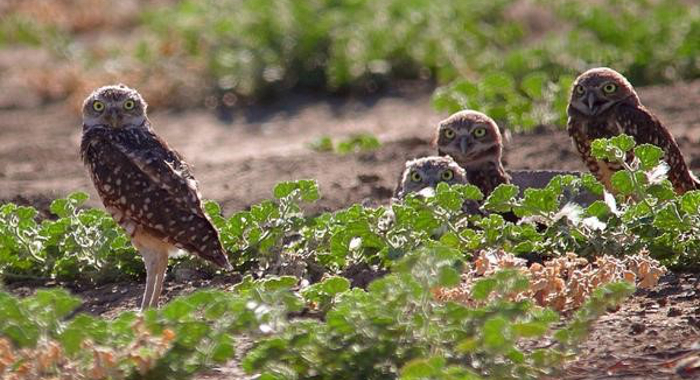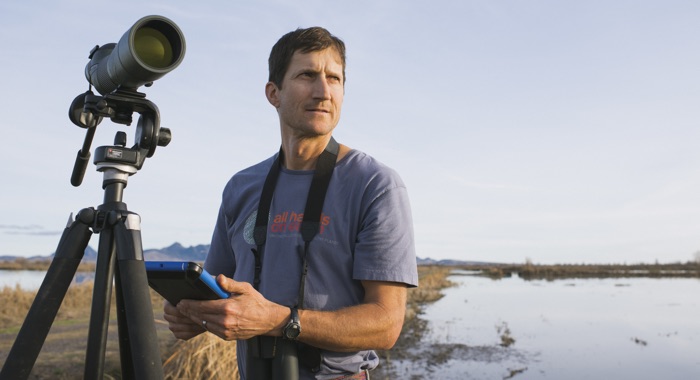California is the leading agricultural state in the country and it’s agriculture generates more than $45 billion annually. About 10 million acres of the state is intensively cultivated land, using roughly 80 percent of the developed water supply. Only a small fraction of these lands are managed deliberately in ways that minimize impacts to nature and maximize the services that nature can provide back to the farm. This has come at a substantial price to nature and the future resilience of agriculture.
Maintaining a mix of natural areas along farm fields and along waterways can provide vital habitat and movement corridors for wildlife, as well as important services like pollination and pest control from native insects, erosion control, and improved water quality. Sustainable management of soils and crops themselves can further reduce the ecological footprint of the land use, and indeed provide habitat for some native species.
Conservancy scientists are investigating these co-benefits, to inform how policy and market incentives could promote food production practices that sustain nature as well as people.


Rodd Kelsey, Abby Hart, H. Scott Butterfield, Dan Vink
Restoring habitat in retired farmland could reduce water demand and provide ecosystem services for farmers and local communities. In some areas of California, as a result of the Sustainable…Walter N. Heady, Brian S. Cohen, Mary G. Gleason, Joshua N. Morris, Sarah G. Newkirk, Kirk R. Klausmeyer, Hilary R. Walecka, Elizabeth Gagneron
Sea level rise presents a new challenge to coastal conservation. The authors quantified and mapped the vulnerability of habitats, imperiled species, and conservation lands to sea level rise throughout…Chris Lortie, Alex Filazzola, Rodd Kelsey, Abigail Hart, Scott Butterfield
Over the past 100 years, California's Central Valley has undergone a massive transformation from desert to a mosaic of farmland and urban development. This transformation has also meant many…Matthew E. Reiter, Nathan K. Elliott, Dennis Jongsomjit, Gregory H. Golet, Mark D. Reynolds
In the Central Valley of California, with 90% of the historic wetlands gone, waterbirds depend upon managed wetlands and seasonally flooded agriculture to meet their habitat needs. The 2013-2015…Alexander C.A.D., F. Poulsen, D.C.E. Robinson, B.O. Ma , R.A. Luster
Management of the Sacramento River and Sacramento–San Joaquin Delta is one of California’s greatest challenges, requiring trade-offs between valued components that serve a multiplicity of…Justine E. Hausheer, Mark D. Reynolds, Greg Golet
Gregory H. Golet, Candace Low, Simon Avery, Katie Andrews, Christopher J. McColl, Rheyna Laney, Mark D. Reynolds
Migratory birds face great challenges due to the climate change, conversion of historical stopover sites, and other factors. To help address these challenges, the Conservancy launched a dynamic…H. Scott Butterfield, Rodd Kelsey, Abigail Hart, Tanushree Biswas, Mark Kramer, Dick Cameron, Laura Crane, Erica Brand
California's Sustainable Groundwater Management Act (SGMA) established a framework for sustainable, local groundwater management. SGMA requires groundwater-dependent regions to…Energy+Environmental Economics for The Nature Conservancy, Arne Olson, Doug Allen, Vivian Li, Emily Leslie
California leads the nation in the transition to a clean energy economy. However, current transmission planning processes limit development of new renewable resources. This report (slide deck),…D. Richard Cameron, David C. Marvin, Jonathan M. Remucal, Michelle C. Passero
Combatting climate change will require using all available tools, especially those that contribute to other societal and economic goals, such as natural resource protection and energy security.…Sacha K. Heath, Candan U. Soykan, Karen L. Velas, Rodd Kelsey, Sara M. Kross
This paper discusses the potential for on-farm habitats along field margins as a conservation strategy within intensively cultivated landscapes. Specifically, the study examined the effects of woody…Emma C. Underwood, Rachel A. Hutchinson, Joshua H. Viers, T. Rodd Kelsey, Trisha Distler, Jaymee Marty
This paper discusses and provides modeled estimates of the biodiversity and ecosystem service outcomes of three different future land use scenarios, compared to current land uses, in a cultivated…Carrie Schloss, Elizabeth O'Donoghue, Christa Cassidy, Tom Robinson, Serena Unger, Adam Garcia, Dan Rademacher
The Bay Area Greenprint tool provides land use and infrastructure agencies, consultants, and advocates easily accessible, interpretable, and scientifically robust information on habitat and ecosystem…Kristen E. Dybala, Neil Clipperton, Thomas Gardali, Gregory H. Golet, Rodd Kelsey, Stefan Lorenzato, Ronald Melcer, Jr., Nathaniel Seavy, Joseph G. Silveira, Gregory S. Yarris
Quantitative population objectives are necessary to achieve conservation goals of secure or robust wildlife populations, however, existing methods for setting them often require extensive…Patrick Baur, Laura Driscoll, Sasha Gennet, Daniel Karp
Since a deadly outbreak of pathogenic E. coli in California spinach in 2006, produce growers have been pressured to implement on-farm practices, such as native vegetation removal, in the name of food…Christopher J. McColl, Katie Andrews, Mark Reynolds, Gregory H. Golet
In response to the decline of wetland habitats for migrating and wintering water birds in California, the Conservancy developed a program called BirdReturns that creates “pop-up”…Daniel S. Karp, Rebekah Moses, Sasha Gennet, Matthew S. Jones, Shimat Joseph, Leithen K. M'Gonigle, Lauren C. Ponisio, William E. Snyder, Claire Kremen
Food safety concerns have led to pressure on farmers to simplify their farms and landscapes, rather than diversify them. This study demonstrates that two practices – elimination of…Sara M. Kross, T. Rodd Kelsey, Chris J. McColl, Jason M. Townsend
Globally, loss of biodiversity and impacts to natural services and human health have been driven to a significant degree by loss of natural habitats due to agricultural land conversion and management…Tamara S Wilson, Benjamin M Sleeter, D Richard Cameron
This publication discusses how land use changes in Mediterranean California will drive changes in water use between urban uses and annual vs. perennial crops. The authors used a state-and-transition…